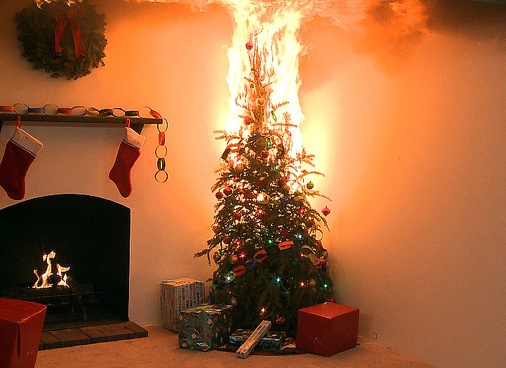We recently discussed the importance of testing and maintaining your smoke alarms, especially during the holiday season. Two big reasons are the tree and the decorative lighting. According to the National Fire Protection Association (NFPA), there were an average of 230 Christmas tree fires a year between 2006-2010. These fires caused $86.5 million in property damage.
Proper placement, selection and maintenance are all it takes to keep your tree a beacon of the season instead of a fire hazard.
- Don’t put the tree near your fireplace, radiators or other heat sources. It does create a nice holiday ambiance, but one drifting ember and your Christmas tree can become the fuel for an indoor bonfire. The NFPA notes that 1 in 5 Christmas tree fires from 2006-2010 were a result of the tree being too close to a heat source. The tree should be at least 3 feet away from anything that generates heat, including lights.
- Don’t block exits. A Christmas tree can pose another potential fire hazard if it blocks exits or paths to an exit.
- Check for the fire retardant label on artificial trees. If you choose to go faux, only buy a tree that clearly states it is certified fire retardant.
- Water your Christmas tree regularly. You should water your tree as soon as you put it in the stand and every day thereafter. The less you water, the more dried out the tree is going to get. If you’ve ever built a fire before you know that dry wood is perfect kindling. The video below shows how big a difference there is in the flammability of a dry Christmas tree versus one that’s well watered.
- Choose a tree that’s fresh and green. On the same note, when you purchase a tree pick one that’s not already on the dry side. Needles should be green and not fall off easily.
Christmas Lighting Safety Tips
- Use lights for indoor use. Lights can be rated for indoor or outdoor use. Never mix the two when you’re stringing them together, and only use indoor lights on your Christmas tree.
- Invest in new lights when needed. If you notice that your lights look worn in any spot, have exposed wiring, or have loose bulbs, it’s time to replace them. These are serious fire hazards that can easily be avoided. New lights also have fused plugs, which prevent sparks if there’s a short circuit.
- Replace bulbs carefully. Only switch out lights when the strand is unplugged and make sure to use the correct wattage on the replacement.
- Turn off the lights when you leave or go to bed.
- Don’t cause an electrical overload. Spread your lights out between electric sockets or use a surge-protected power strip. Resist the urge to string many light strands together. It is more convenient, but it also causes more load on your electric socket.
- Never run cables under carpets and rugs. This can damage the integrity of the cords.
One last safety tip: it’s time to retire your Christmas tree when the needles begin dropping. Don’t keep it in the house, garage or up against the structure. Check to see if there are local tree recycling programs that will help you get rid of it safely.
Image Source: www.flickr.com/photos/uscpsc/8263455073
Original Source: http://www.mybiginsurance.com/austin-community/top-12-christmas-tree-lighting-safety-tips


